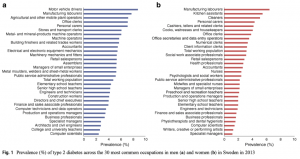A new study reveals that certain occupations have up to a three-times-higher risk of developing diabetes. The Institute of Environmental Medicine at the Karolinska Institutet in Stockholm recently published results of a study that examined diabetes rates of about 4.5 million Swedish adults who were employed between 2001 and 2013. The goal of the study was to see where risks and prevalence of type 2 diabetes were highest among all populations in Sweden.
About 8% of all Swedish adults have diabetes; about 4.2% of working adults have the disease. Rates varied by profession, the study found, with higher rates among professional drivers and manufacturing laborers in male subjects and manufacturing workers, kitchen assistants, and cleaners in female subjects.

The study’s lead researcher, Dr. Sofia Carlsson, speculates that irregular hours and shifts, stress, and sleep time associated with these professions could explain some of the increased risks.
Implications For Employers
The findings have significant implications for employers globally. In the United States alone, about 30.3 million adults have type 2 diabetes and another 84.1 million have prediabetes. Diabetes cost employers about $20 billion in unplanned sick days in 2017.
The study shows that identifying employees and professions at greater risk for developing the illness could help target those individuals for company-initiated intervention. “A randomized clinical trial in the U.S. in the early 2000s showed lifestyle modification counseling reduced the risk of type 2 diabetes by around half,” said Carlsson. In that trial, participants with diabetes were asked to reduce their weight by about 5%, increase physical activity, and add a 70-minute brisk walk to their schedule each day.
In the workplace wellness space, there are two kinds of programs or interventions: wellness programs and disease management programs. The former program often addresses lifestyle programs that encourage individuals to move more, eat better, etc. while the latter program is designed for individuals with one or more chronic conditions and focuses on managing an illness. By the time an individual is ready for a disease management program, they would already be sick and suffering from a chronic illness, such an diabetes or hypertension.
More and more employers are recognizing it is less expensive and more helpful to prevent chronic diseases rather than trying to manage them once them once established.
Wellness Programs May Be Key
Physical activity could be the first step to preventing type 2 diabetes, and wellness program designers and administrators have a tremendous opportunity to use a wellness program to implement preventive measures, especially within at-risk populations.
U.S. Centers for Disease Control and Prevention (CDC) statistics continue to reveal that most Americans do not get the recommended levels of aerobic and muscle-strengthening activity necessary. As of 2018, only 23.2% of adults 18 and over met the physical activity guidelines for both types of activity.
While it’s not always easy to encourage employees to get more physical activity during the workday, some programs have shown promise. In 2011, O’Neal Industries of Birmingham, Alabama, initiated a program that included some on-site physical fitness facilities. By 2014, 400 of the company’s 3,000 employees had initiated or improved their fitness levels enough to result in an overall net cost savings of over $500,000. At American Cast Iron Pipe Company, a program that began in the 1990s and includes an onsite fitness center and exercise instructors has resulted in a health risk reduction of nine percent.
Wellness program elements that can help encourage participation include:
- Gamification: Introducing elements of gamification can improve wellness program outcomes
- Flexibility: Wherever possible, employers should give employees flexibility in schedules to allow for physical activity, such as allowing longer lunch breaks to give employees time to walk or run
- Community: Worksite classes with exercise instructors can encourage a community approach to physical activity and help build a workplace culture of health
- Creativity: Managers can schedule walking meetings instead of using a conference room and employers can sponsor teams in walking or running events
Workplace wellness programs have the potential to make a significant impact on rates of type 2 diabetes by encouraging increased physical activity during the workday and giving those most at risk a chance to prevent the illness in the first place.












